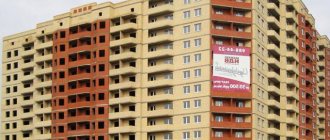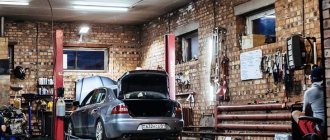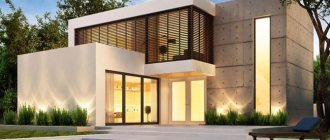Interest in high-rise construction is steadily growing in Russia. Today, half of all apartments under construction have 18 to 24 floors. So, for example, the average height of new buildings in the capital has increased by three floors over 2.5 years. This is stated in a study by the Moscow Real Estate Investment Agency.
According to the results of the study, between May 2021 and December 2020, the average number of floors of new projects in Moscow increased from 21.6 to 24.7 floors. Low-rise residential complexes—up to eight floors—account for about a third of the proposals.
Article on the topic From “Stalinists” to “Brezhnevkas”. How the housing problem was solved in the USSR According to experts from the Unified Register of Developers (URZ), by 2022, monolithic technologies may be halved, brick will lose about 5% of the market in the next few years, and block construction, on the contrary, will gain about 4%. Experts explain the active growth of this segment by the fact that such houses can be built many times faster than monolithic ones at a comparable level of quality. In terms of hydro-, sound- and thermal insulation, modern panel and block houses are already on par with monolithic ones. This has been facilitated by new technologies that allow for greater diversity in facades and layouts.
Features of block construction
Modern projects for the construction of buildings from prefabricated blocks attract many potential new residents. The low cost of “reinforced concrete” suits young families and students purchasing their first apartments or expecting the birth of children. Most large developers have their own concrete plants as part of their holdings, so the absence of markups makes the construction of such buildings economically profitable. The finished blocks are connected with cement. There are two technologies for their production:
- foam block;
- gas block.
In both options, the concrete is foamed, which ensures lightness of the structure and a high level of noise absorption and excess thermal radiation. Such buildings do not have the main disadvantage of those built from panels - poorly sealed joints, so the sound insulation and thermal conditions in them will be more optimal. Also, block structures are more resistant to ground subsidence and soil vibrations; living in them is less alarming in earthquake-prone areas.
Comparison
The main difference between a panel house and a block house is the use in the construction of the former of those panels, the width of which in most cases corresponds to the height of the ceilings in the rooms. The blocks used in the construction of houses of the second type are usually several times smaller than the designed ceiling height. In other aspects (material of manufacture of the main building elements, heat and sound insulation indicators, redevelopment possibilities) of the type of structure under consideration are very similar.
Having studied the difference between a panel and block house, we will reflect the conclusions in the table.
Advantages of a block house
Quick and technical assembly of a new multi-storey building from ready-made cubes will give the owners the opportunity to wait no more than a few months for occupancy. The technology of constructing a building from ready-made materials guarantees:
- fast construction and receipt of keys to the apartment;
- predictable quality of an object.
Also, the main advantages of a high-rise building assembled from blocks will be:
- Good sound insulation. The structural elements absorb external noise, so residents will not be disturbed by the crying of a child or the clatter of a neighbor’s heels.
- Frost resistance. The building is significantly less cold in winter than its panel competitors.
- Less risk of fires.
- Simplicity of finishing. The blocks easily accept wallpaper, painting, and plaster.
Note: When building your own country mansion, block technology can be used. Its only disadvantage will be the inability to create an individual architectural solution.
Design difference
What is the difference when designing block houses and panel houses? What difference does it make, by and large, what the building will be built from if it is still only being drawn on paper? But it is there. Most often, block technologies are used for the construction of private country houses according to the customer’s individual project, because here it is really possible to show the strength of the architectural idea and emphasize the individuality of the customer. But panel buildings are being built within the city limits, the primary reason being the possibility of building a multi-storey building. This is primarily due to the number of inhabitants and the speed of construction. In any case, no matter what type of building will have to be inhabited, it is worth remembering that all cracks and openings serve as a source of noise, heat loss and unwanted dampness and organic appearance. Particular attention should be paid to sealing joints and finishing window and door slopes.
Features of a panel high-rise building
It is impossible to decide which house is better - panel or block - without knowing all the intricacies of construction and what unpleasant surprises new residents can expect. The first buildings of this type began to be built in the 60s of the 20th century. Their service life is 100 years, so they remain an essential element of the urban landscape. If in the Soviet period the quality of construction was closely monitored, in modern Russia many developers who entered the market were unable to maintain the required level of quality. Panel houses were built in haste; they had such disadvantages as:
- cracks in the walls;
- poorly sealed interpanel seams;
- flying tiles.
Which house is better to choose?
We have looked at how a block house differs from a panel house (see photos of buildings in the review). But which one should you choose? If you rely on comfortable living, then your choice should be on a block house, but if you rely on the financial factor, then a panel house will cost an order of magnitude cheaper than a block house. The design of a block house allows for individual redevelopment. In a panel house, the walls are characterized by significant surface unevenness, which makes repairs problematic. Therefore, the walls and ceiling are often sheathed with plasterboard, which allows you to achieve a perfectly flat surface, and also has heat and sound insulation properties, and additional insulation is placed between the wall and the plasterboard. Basalt wool is used more often because it is made from natural, environmentally friendly material and is not flammable.
To answer the question: “What is the difference between a block house and a panel house and which one is better?”, you need to individually study each project, its technological features and standards. Today, panel house construction has been improved, there are various layouts, improved insulation and other useful construction trends; the only drawback is poorly sealed seams at the joints. However, for a family with children, a block house remains the best option, because it does not require lengthy repairs and the installation of climate control equipment, which is not recommended for use for preschool children. In panel houses, the width of the panels is equal to the height of the ceiling, so the height is built to a standard one. In block structures, you can build a room of any height allowed according to GOST, because they are small in size and to lay one standard wall you need to lay out 7-10 rows of blocks.
Advantages of panel construction
The panels have not only disadvantages, but also significant advantages, which not everyone knows about. When choosing what to buy and comparing a block house and a panel house, you will have to feel the difference after some time, after going through the stage of finishing and repairs (for secondary housing). Among the points that will manifest themselves after 3-6 months of operation:
- Factory technology for manufacturing panels ensures stable and uniform quality of the material; production does not depend on possible human error.
- Uniform subsidence of the building, the walls will not crack as a result of misalignment.
- The cost is 20-40% lower than that of a brick house with a comparable useful life.
- The apartments already have interior partitions; they do not need to be created at the expense of the new tenant. The new owner will receive a ready-made layout, rather than a single concrete space.
Important: In panel houses it is often necessary to make repairs immediately after purchase, but the price of such repairs will be low; most of the costs will be borne by the management companies.
Disadvantages of panel houses
The disadvantages include, firstly, low heat and noise insulation, because concrete has low insulating properties, and the seams between the floors, which also serve as a source of noise penetration and heat loss, are poorly insulated. Frequent condensation leads to dampness, mold and heat loss. These are standard buildings, where each floor in the plan has the same layout; it cannot be changed, because it is forbidden to demolish load-bearing walls and make openings in them. In these houses, all rooms have a small area, the house heats up quickly in the summer and cools down quickly in the winter, so in a panel apartment for comfortable living you need to use climate control equipment all year round. Especially in corner apartments, there is a frequent occurrence of mold and dampness. However, today, for the construction of such houses, not one reinforced concrete slab is used, but two layers are used, and insulating material is laid between them.
Nuances of choice
Understanding the difference between a block house and a panel house, you can decide to buy an apartment. In this case, the choice of object will also be based on the quality of work of the service departments, since the management company will have to eliminate construction deficiencies. Panel houses have significantly more disadvantages, but if you need to quickly purchase inexpensive housing, they can be smoothed out. In the last decade, the production parameters of this type of material have changed, so it has become possible to create higher ceilings and spacious rooms in high-rise buildings.
Advantages of a panel building
The slabs for the construction of a panel house are manufactured at the factory using mechanized machines with the least amount of human effort. Therefore, the quality of the building material is very high, without errors. Also, these houses are built as quickly as possible. The structure shrinks the base evenly, so repairs can be made after construction, but windows can be installed during construction and after completion. What is the difference between a block house and a panel house? The cost of panel apartments is 25-40% lower than that of block apartments. However, panel buildings have high strength and durability. The slab works in tension-compression, namely the reinforcement in tension and bending, and the concrete in compression, that is, these characteristics do not allow these processes to occur. Considering the question: “What is the difference between a block house and a panel house, which is better?”, it is worth considering the disadvantages of buildings.
Video description
For an analysis of one of the typical designs of reinforced concrete houses, watch the video:
Foundation
Most often, a strip or monolithic concrete base is used for a panel house. Sometimes a pile foundation can be used, but since piles are expensive for heavy houses, such decisions are made in very rare cases.
Otherwise, the stages of work are standard: marking, digging a trench below the freezing depth of the soil, then formwork is done, reinforcement is performed and concrete is poured at least grade M 400.
Panels and ceilings
The next stage in the construction of a building is the installation of walls and ceilings. The construction of a house from reinforced concrete panels is carried out by a professional construction team using a crane. Wall slabs are fastened together by welding to a reinforcing frame.
Design of a house and utilities
The design of a cottage made of reinforced concrete slabs is developed down to the smallest detail, and the dimensions are agreed upon with the manufacturer. This is of particular importance, since the slabs will no longer be processed.
It will be almost impossible to change the layout of a reinforced concrete house in the future Source firstcostconceptz.com
When developing a project, it is imperative that special attention be paid to the following points :
- The location and number of door and window openings, their configuration and dimensions.
- The presence of technological channels for wiring, ventilation, etc.
- Number of rooms and their parameters.
- Compliance of components.
To develop a project for the construction of a private house or cottage, you can use one of two options:
- Use standard projects that are always available from any construction company.
- Order an individual project, but in this case you will have to wait until the panels are made for it at the factory.
What is a modern reinforced concrete panel for the construction of a private house
Even judging by the name alone, a reinforced concrete panel is a concrete slab, inside of which there is steel reinforcement, which improves the concrete's resistance to mechanical stress and increases strength under lateral loads.
All panels are divided into three types :
- External.
- Internal interior slabs.
- Floors.
External walls can be one, two or three layers. In the latter version, the inner layer is insulation, and the outer surface of the slab is made of high-strength concrete.
Wall panels, in turn, are divided into the following types :
- Bearers.
- Self-supporting.
- Hanging slabs.
From the name it is clear that the initial ones are the basis of the building. The following panels are independent elements and they are fixed to the load-bearing walls and floors of the house.
A reinforced concrete house is assembled from slabs for various purposes, which optimizes the overall cost Source mypresentation.ru
Table
| Panel house | Block house |
| What do they have in common? | |
| The panels and blocks used for the construction of the structures in question are made of reinforced concrete | |
| The types of houses under consideration are similar in terms of thermal and sound insulation characteristics, and are difficult to redevelop. | |
| What is the difference between them? | |
| Made from panels whose width corresponds to the height of the ceilings in the rooms | Made from blocks, the width of which is usually several times less than the height of the ceilings |
Build it yourself or order a turnkey service
Today, many people dream of owning their own home - this means freedom, complete isolation from noisy neighbors behind the wall, and live communication with nature in their garden.
To fulfill your desire, there are two options: build a house yourself (even with the help of hired workers) or order the work from a professional construction company. At the same time, the price of the issue at first glance seems completely different, but where you will find it and where you will lose it needs to be examined in more detail.
Building a new house yourself
It is simply impossible to build a house from reinforced concrete panels on your own, so we will simply compare the stages with the construction of an ordinary cottage.
Initially, you will have to order a house project. This is not just a layout drawing, but technical drawings that indicate the location of the house on the site, calculate the forces of the floors and other data according to which the house can be built.
You must understand that the layout and appearance are only an architectural project and it is still impossible to build a house based on these data Source pinterest.com
Next, you will have to organize the purchase and delivery of building materials. In addition, you will have to choose these materials yourself, which can be quite a difficult task for a person without construction experience.
Even now, the construction of the house has not yet begun, since many issues will need to be “sorted out,” in particular, to obtain a building permit (here, by the way, you will also need an approved project)
When the paperwork is resolved, construction can begin. Here everything depends on whether you will build completely yourself or attract additional labor. There are pitfalls here and there. If you look for workers, then the first question is their qualifications, which, let's face it, is a matter of chance. In addition, the workers will have to be constantly monitored, and since you have other things to do besides construction, it’s simply not possible to keep track of everything.
In any case - during independent construction or when involving workers, if after some time any defects appear, then you will have to correct them yourself, since the “gray” construction team will not give you any warranty obligations. And even if he does, in a year or two where will we look for these workers?
Not all builders’ shortcomings can be noticed immediately Source anayemeni.net
As a result, it is almost guaranteed that the cost of a house when erected on your own will be significantly higher even during construction, compared to the initial calculations. And this does not take into account the costs of correcting possible defects that will appear after some time (if they can be corrected at all without dismantling the house).
Turnkey construction
Even if you just go through the points listed, the difference will already be quite noticeable:
When you order, a serious construction company will make you a house design for free. In addition, this project will be read by builders without any problems, because despite standardization, even a specialist will have to understand an unfamiliar project. Plus, designing a private panel house is relatively simpler, and therefore faster.
The construction company takes care of all the accompanying documents and permits, which saves you time.
The selection of workers is also the concern of the construction company and they treat this issue responsibly, because the built house is guaranteed.
When ordering turnkey construction, you only need to approve the project you like Source stroika.proraion.ru
Another advantage of the contract is that it states a fixed estimate, which means that everything after signing the document will only have to be paid for the pre-agreed amount.
In addition, the construction of a turnkey cottage from concrete panels will not take long - in fact, a construction crane will arrive and with its help the designer will assemble it. It is clear that the designer’s parts will be assembled at the factory for some time, but all deadlines are in any case specified in the contract and the house will be ready on the agreed date.
See also: Catalog of companies that specialize in the construction of turnkey country houses from reinforced concrete panels.









